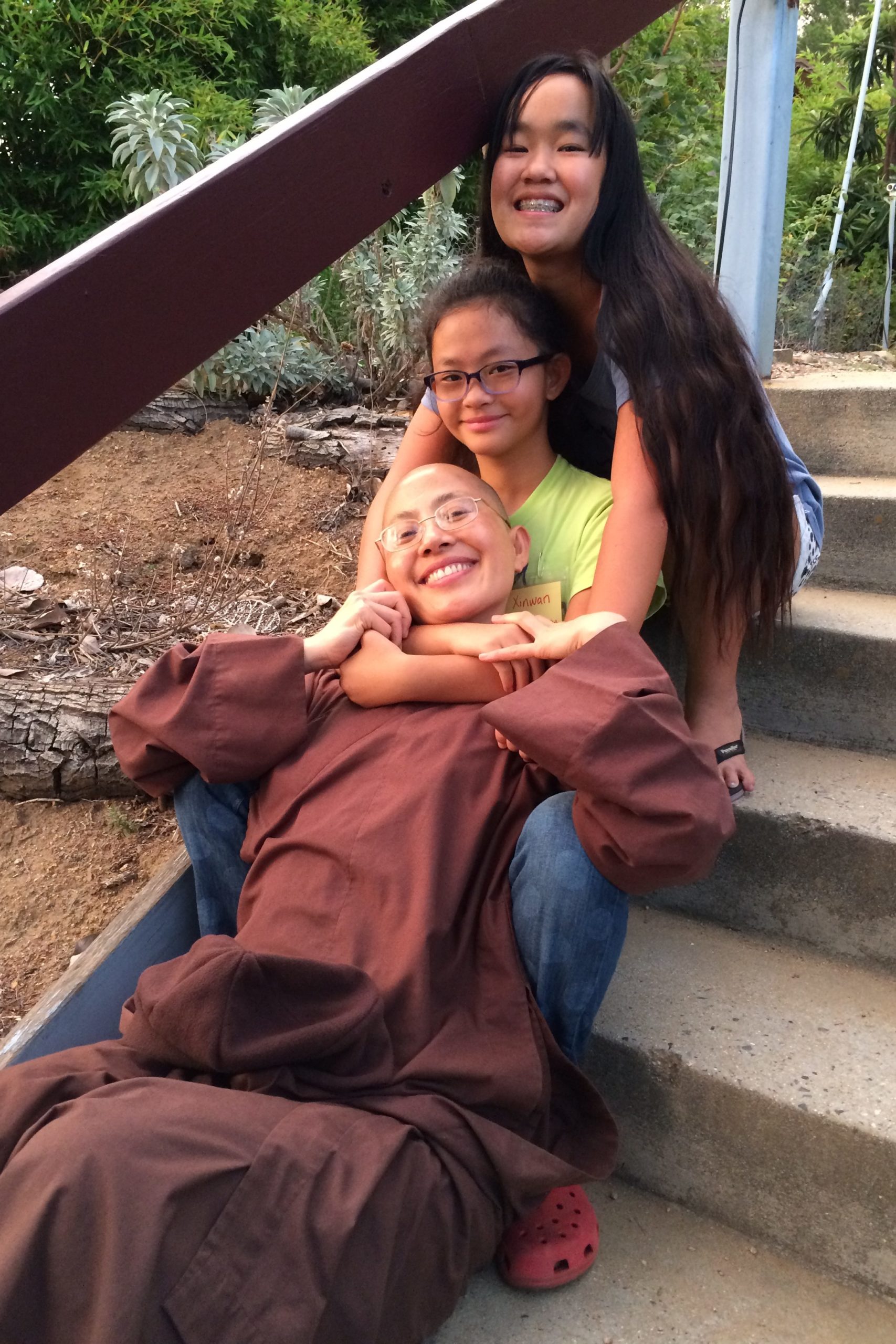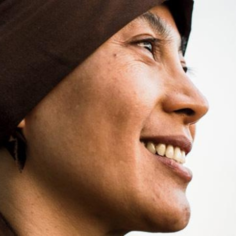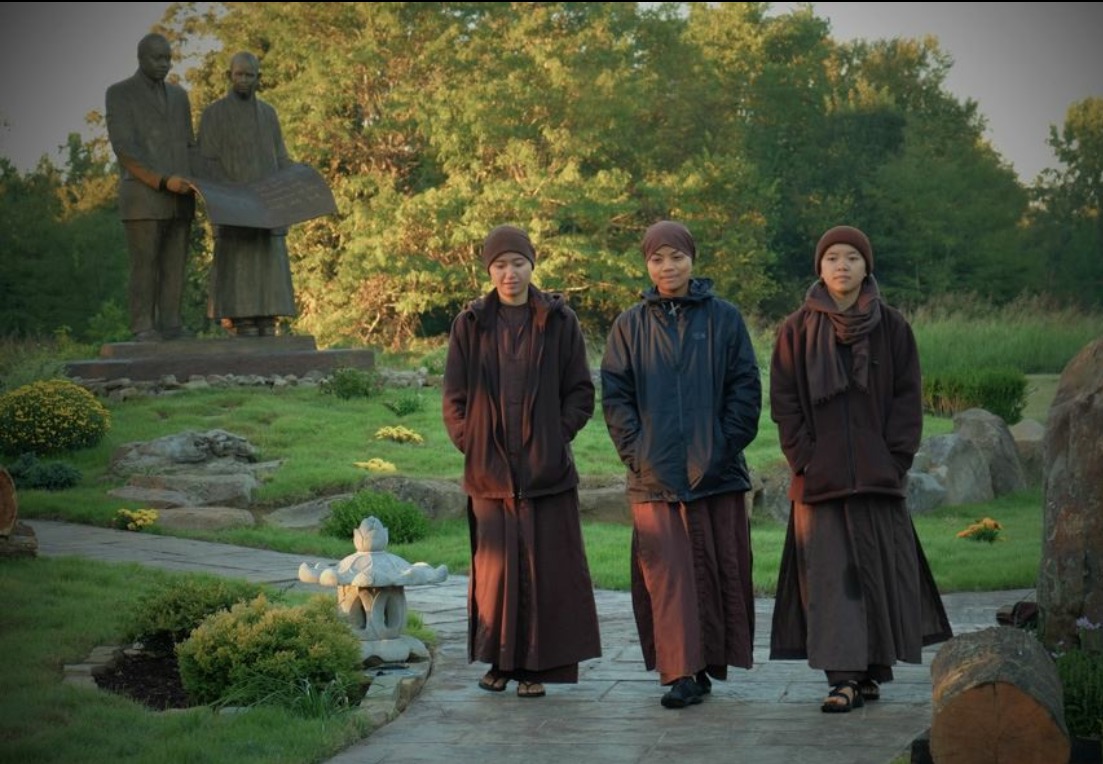By Sister Dang Nghiem in June 2016
Homage to the Buddha Shakyamuni.
Dear beloved teacher, respected monastic brothers and sisters, and dear noble community, several years ago we had a teaching tour in Southeast Asia. One evening in Taiwan, our teacher taught about the Four Gratitudes: gratitude to our parents who gave us this body and this life; gratitude to our teachers who have brought us to the spiritual path,
By Sister Dang Nghiem in June 2016
Homage to the Buddha Shakyamuni.
Dear beloved teacher, respected monastic brothers and sisters, and dear noble community, several years ago we had a teaching tour in Southeast Asia. One evening in Taiwan, our teacher taught about the Four Gratitudes: gratitude to our parents who gave us this body and this life; gratitude to our teachers who have brought us to the spiritual path, who teach us love and understanding; gratitude to our friends who go through difficult and joyful times with us; and gratitude to all living beings—the animals, the plants, the minerals. Our teacher added two more: gratitude to his students and gratitude to our lay friends who walk with Thay on the path. As I sit here in the place of our teacher, in the place of our elder brothers and sisters, I remember those six gratitudes. I feel very concretely that Thay is in each one of us, every moment we are mindful. Every moment we come back to ourselves, Thay is right there, because his whole life, he has transmitted only that.
TRULY A FAMILY
The children I have worked with have become teenagers and young adults. I met Sunyata before he was conceived. His parents came here, to Deer Park Monastery, before his mother was pregnant with him. His parents made the effort to come here as often as they could while they were nurturing him inside of them. And then Sunyata was born. He came here as a very young baby, just a few months old. I remember one time when he was only one year old, and there was a sound of the big bell. Everybody stopped. He looked around, and I said to him, “Sunyata, bell! Breathe! Bell! Breathe!” As monastic brothers and sisters, we do our best to introduce the practice to children when they are very young.
Xinwan has been coming to Deer Park Monastery since she was three years old or even younger. She used to cry a whole lot! But her adopted parents and the community loved her so. She has practiced and has been able to transform so much of her suffering from being abandoned as a child. She is a teenager now, so beautiful and calm.
I have also seen teenagers become young adults. Young adults, you have grown crows’ feet. It is very endearing to look at those crows’ feet on your eyes and on my own eyes. As a community, we have also seen our friends grow older and some have even passed away. Our community is truly a family to each other over the years. We have gone through so much together. May we continue to grow together.
WE ARE A REPEATING PATTERN
My precious children, I have a very wonderful teaching to share with you. Have you ever seen this plant? It grows in Deer Park Monastery. It is called buckwheat. You can see how one stem gives out to three branches, and then each branch has three more stems or small branches. Do you see that? Even this small branch leads to three smaller branches. One, two, three; one, two, three. It keeps going like that. This is called fractal. In biology, fractal means repeating pattern.
It is the same in us. Our parents have given us this body. When we are little, we cling to our parents; we need our parents for everything—for food, for shelter, for love, for attention, for education, everything. Every word that we know, our parents taught us from the beginning.
At some point, maybe when you were three years old, you started to feel, “I am all by myself; I am a separate person.” I had a friend who, when she was three years old, said to her mother, “Your body cannot tell my body what to do!” Many teenagers say to their parents, “I don’t want anything to do with you!” My brother is three-and-a-half years younger than me. I raised him and took care of him as a baby. When he was in high school, he said, “Sister, don’t stand close to me, don’t hold my hand, because the girls won’t give me their phone numbers.” When we grow up, we want to leave our parents and think that we are separate from them, entirely different people.
But when you look at a fractal, a repeating pattern, do you think that this one can be separated from that one? They are all connected to each other, right? If you pluck this one out, if you disconnect it, it cannot survive very long. In the same way, we are always connected to our parents. Everything that we have came from our parents, which came from their parents, which came from their parents and previous ancestors. Everything in this body and this mind has come from our ancestors—biological ancestors, spiritual ancestors, land ancestors, animal ancestors, plant ancestors, mineral ancestors. Nothing belongs uniquely to us. This teaching is very, very deep.
The other day an elder sister told me, “My young sister, your eyes still look sad. I know you practice quite well, but your eyes are still looking so sad.” I have the eyes of my mother. My mother had very sad eyes. With good practice, slowly I see my eyes change, and my eyes look more like my grandmother’s eyes. They are calmer, more peaceful, but sometimes still sad. When we know that it is a repeating pattern, a fractal, then we know that whatever sadness or anger, joy or talent, unskillfulness or suffering we have, came from our ancestors. We are all intricately connected. With the practice we can transform the sadness, the anger, the suffering for ourselves but also for our parents, grandparents, great-grandparents, and great-great-grandparents.
With everything that you learn in the practice—including mindful breathing and mindful walking—you learn to be aware. In a moment when you see that you are very angry, instead of saying, “I am so angry at that person,” or “This anger is mine and mine alone,” you can say, “Hello, Dad! I know you are here with me.” And when you are anxious and restless, you can say, “Hello, Mom! I know you are here and I am holding you with my stable posture, with my smile. I come back to my in-breath and out-breath to hold your restlessness, your anger, your sadness.”
All you need to do is to recognize that energy. That particular energy comes from your mom, or your dad, or your grandmother, or your grandfather. You say hello to them and simply smile and breathe and relax. Your body and your mind calm down. That energy subsides, and in that moment, you are most beautiful and kind to your parents and your ancestors because you are helping to transform that difficulty in them. Indeed, with the healing from your practice, you are your ancestors in their most beautiful manifestation.
To listen to Sister Dang Nghiem’s full Dharma talk, go to: deerpark.
libsyn.com/fractals-and-interbeing-miracle-of-mindfulness-tour-2015.
Transcribed by Uncle Lam Nguyen. Edited by Sister Dang Nghiem and Natascha Bruckner. Buckwheat illustration from USDA-NRCS PLANTS Database / An illustrated flora of the northern United States, Canada and the British Possessions (1913). By Britton, N.L., and A. Brown. Vol. 1: 672.



